I can't say I have been following Jeff Forster's career for a long time--I first saw his work in April of last year. But he has an old website that seems to date from 2007 and one can see his work has evolved quite a bit. Back then, his work was divided into two groups, Relics and Earthworks & Remnants. It is certainly possible to see in these works the roots of his current work. The "Relics" were ceramics that "stem from modern everyday household forms that society is familiar with." He derived "great satisfaction in reusing discarded items to create art." Forster deliberately made these ceramic pieces look aged--he wanted them to appear to be ancient sacred objects. But for his work moving forward, the key thing is the idea of a relic and the appearance of age. The Earthworks also were created to have the appearance of great age.
In 2010, Forster displayed work at Poissant Gallery that not only looked old, but was actually crumbling. Instead of a stately ruin, the work looks like a neglected mess.

Jeff Forster, Frailty, found object, porcelain, native Houston clay, 2010
My thought after seeing this was that it mimicked what one would experience in an abandoned building. For example, a house that was flooded out during Katrina--what does it look like when you go back after all the water has receded and dried up? Artists and architects have long been fascinated by ruins--one need only think of the etchings of Piranesi or the follies (sham ruins) of 18th century England. But Forster is doing something a bit different. Those earlier lovers of ruins imagined a cleaned-up idea of the ruin compared to Forster's debris-strewn floor. But I think the relationship is strong, and as a consequence, I think we could apply to Forster's work in this vein an 18th century word, picturesque.
But among all the objects of art, the picturesque eye is perhaps most inquisitive after the elegant relics of ancient architecture; the ruined tower, the Gothic arch, the remains of castles, and abbeys. These are the richest legacies of art. They are consecrated by time; and almost deserve the veneration we pay to the works of nature itself.(William Gilpin, Three Essays on Picturesque Beauty, 1794)I think in Forster's work, we have a modern interpretation of the Picturesque--perhaps the Enlightenment-era notion of the picturesque combined with nostalgie de la boue. This is something I can relate to. I take an indecent pleasure in seeing pictures of destroyed cities and towns--whether the result of natural disaster or war or mere neglect. And the ubiquity of such images of "disaster porn" in the mass media suggest I am not alone in this shameful voyeurism. The Sex Pistols got it right when they referred to "a cheap holiday in other people's misery." After all, when we see something like Frailty, it is implied that something bad happened. Buildings aren't abandoned for good reasons. Eviction, delinquent taxes, bankruptcy, fcoreclosures, etc.--these lie behind this work.
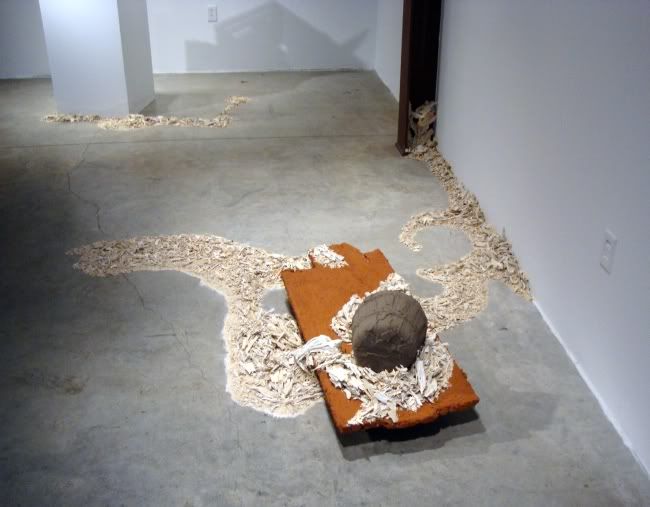
Jeff Forster, Endangered Species, native clays and palm fronds dipped in porcelain then fired, 2010
He pushes it even further in Endangered Species (from an exhibit in September 2010 at the Art League). While frailty had the remains of a wooden box mounted on the wall, Endangered Species is a portrait of total decay. Two nondescript objects are on the floor surrounded by a partially swept nimbus of random ceramic flakes. One might wonder where the structure is here? The answer lies in the walls of the Art League's gallery. As an installation, Endangered Species uses its space as part of the piece itself. The gallery is the ruined building, its floor scattered with debris.
Still, these smallish pieces by Forster suggest that with more space, he could build a structure--the actual ruin. That's what he did with Abandoned, which was shown this summer at the Houston Center for Contemporary Craft's show of former artists-in-residence, Crafting Live(s): 10 Years of Artists-in-Residence.
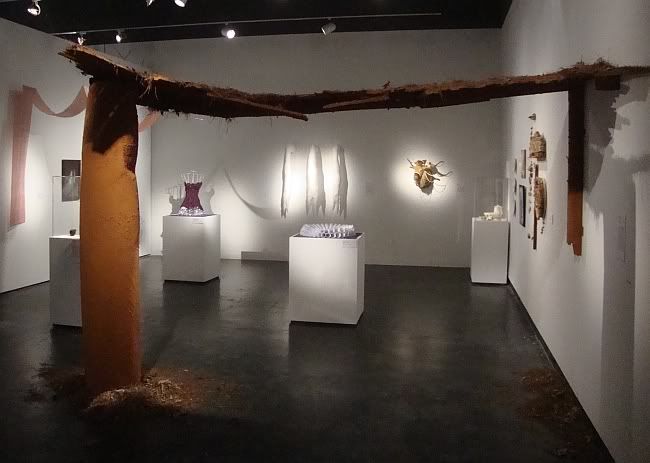
Jeff Forster, Abandoned, reclaimed wood, concrete, local vegetation, native clays, 2011
Abandoned takes the ideas he developed in Frailty and Endangered Species and pushes them about as far as they can go in a gallery setting. Here we clearly see the remnants of a structure.It appears to be made of wood, with straw or pine needles on the roof. One could imagine stumbling across it in rural West Texas or Northern Mexico. My grandparents had a small farm in Louisiana. By the time I started visiting them, they were too old to farm and had leased their land to timber companies. In the woods (formerly fields), there was an old long-abandoned sharecropper's cabin. This piece stirred strong memories of that cabin. It too was strewn with detritus that hinted at the lives of its former inhabitants.
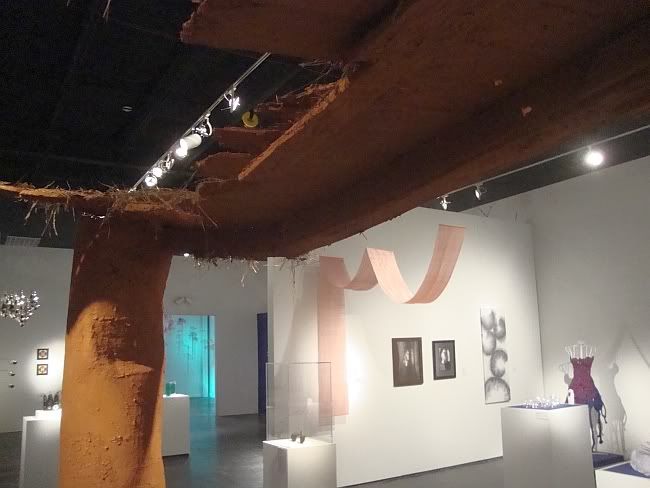
Jeff Forster, Abandoned (detail), reclaimed wood, concrete, local vegetation, native clays, 2011
This leads us to Forster's current work, a solo show called Detritus currently on view at Lawndale. To advance his postmodern picturesque effect, he has had to move his work outside, into Lawndale's back yard. Each of the pieces in the show has its own name, but I can't match the names to specific pieces, so please forgive my imprecision.
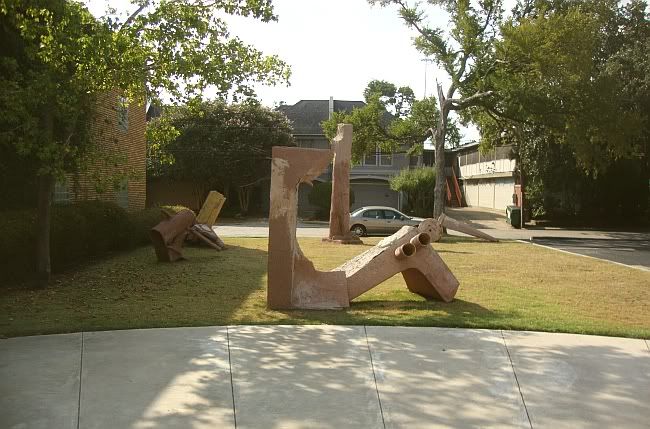
Jeff Forster, Detritus installation, reclaimed fencing and lumber, steel, local vegetation, concrete, adobe, paint, local and recycled clays
The first thing I noticed was how neat and tidy everything was. These large, somewhat abstract shapes are carefully spread about Lawndale's neatly manicured (if somewhat dry) lawn. They seem designed to suggest the ruins of obscure industrial structures. As someone who has looked at a lot of Forster's earlier work, the second thing I noticed was the lack of small broken bits of ceramic refuse, as we had seen in Frailty, Endangered Species, and Abandoned.
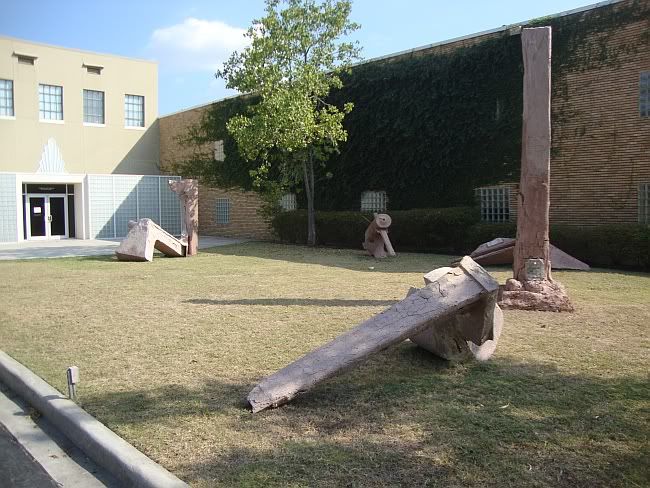
Jeff Forster, Detritus installation, reclaimed fencing and lumber, steel, local vegetation, concrete, adobe, paint, local and recycled clays
I pointed out the difference between Forster's work and the Picturesque of Gilpin and Horace Walpole. Those 18th century Englishmen didn't want actual ruins--they weren't looking for burned-out cities or weed-strewn lots. They placed their faux ruins in carefully designed gardens. The power of Forster's earlier pieces was in their feeling of actual decay--places where some tragedy had happened and which no one had touched since. A sharecropper's cabin with the litter of old newspapers and 1930s Sears catalogs on the floor. That is not what we see in Detritus, despite its name. It is closer to a folly like the Jealous Wall -- a beautifully constructed sham ruin artfully set in a lovely lawn.
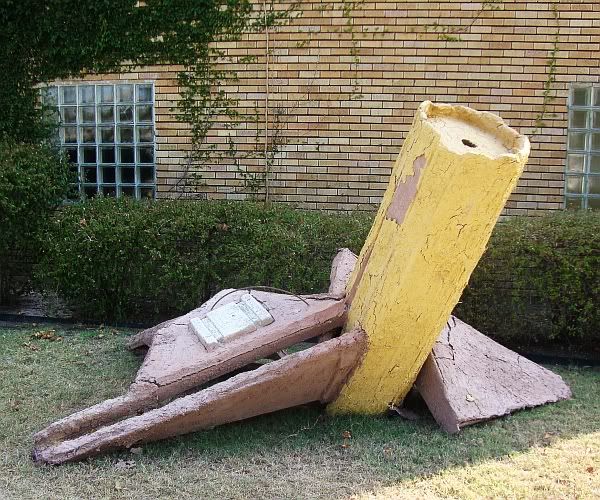
Jeff Forster, Detritus installation detail, reclaimed fencing and lumber, steel, local vegetation, concrete, adobe, paint, local and recycled clays
In expanding the scale of his work, Forster has moved closer to the 18th century ideal of the picturesque. I don't see that as a forward step. Detritus lacks the power of his earlier work. It feels like a misstep. When Kara Walker, for example, makes use of a quirky 18th century art form (silhouette), she gives it a modern resonance--and power. Forster seemed on that path until now. But as someone who is following Forster's experiment with updating the picturesque, I am hoping that he will move past Detritus. Perhaps what Forster needs is a piece of property where he can build a relatively permanent folly. A project like that would be similar to an earthwork, or to La Ribaute, Anselm Kiefer's "city" in France. Given several acres, Forster could build his own folly, perhaps a complex of ruined structures--structures that would decay naturally over a span of years. It would be a monument to entropy.
(Here I have to acknowledge that I own a piece of Forster ceramic--I bought it at a Box 13 fundraiser in 2010. And I have to acknowledge as well that when I own a piece for an artist, that puts me in the position of rooting for his or her artistic success.)




No comments:
Post a Comment